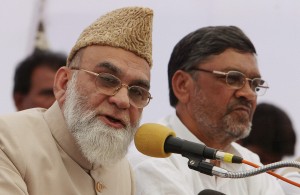
Profiting from Loss: India and the Right to Reproduce
by Katherine Cowles | March 5, 2015
“With all these vigilant vigils on virginity, you would think the country would have controlled its population by now.” ― Mallika Nawal, I’m a Woman & I’m on SALE.
With roughly 1.27 billion people, India’s population is the second largest in the world. Projections for growth maintain that by 2030 the country will knock China off the top spot. Doubtless, overpopulation and its dangers lie at the surface of India’s vast sea of troubles. The largest in Asia, Dharavhi slum alone is home to an estimated population of between 600, 000 to one million people; by 2017, slum population nationally will rise to 104 million.. Population control is essential: as it stands, the Indian government is grappling with an increase of 45,000 persons daily, which means the population of a new Birmingham in under a month. Clearly ‘vigils on virginity’ are not enough; government action in India has shown that it is easier to change bodies than adapt mindsets – and more permanent.
Is female sterilisation the answer? With the oldest programme in the world, family planning has always been at the centre of India’s plans for population control, and today its state-run Family Welfare Programme continues to rely heavily on permanent solutions – for the most part, tubectomies, a procedure which involves blocking or tying the fallopian tubes to prevent the woman’s eggs from meeting the sperm. The treatment is 99% effective and 100% irreversible. Rigorous promotion of the smaller, nuclear family as a social norm – raising sex-selection issues of its own – may well have given way to the trend of having few children beginning to take hold of India’s growing middle class, but this movement alone is considered insufficient. Prime Minister Modi’s government’s sterilisation drive has instituted family planning clinics nationwide that have been dubbed “sterilisation camps”; An extreme image, perhaps, but one not so far from the truth. Roughly 4 million patients have been sterilised over the past year, among which only 37% were married women. Given the inaccessibility of many contraceptive options, particularly in rural areas, sterilisation, as a ‘consensual’ method is neither an impractical nor unpopular solution.
But its popularity is a curse. With a constant stream of patients flooding through camp doors, sterilisation has become a factory scale process. The deaths of at least 14 women in ‘camps’ in one of India’s poorest states, Chhattisgarh, are testament to the slapdash undertaking of certain sterilisation procedures that , should be harmless. The recent deaths indict the administrators’ neglect for safety measures, in particular in the use of post-op drugs and the sterility of the operating tools employed.
India has a long history of institutionalised sterilisation projects: in the 1970s, an extreme drive for male sterilisation, resulting in widespread civilian-victimizing by groups of armed policemen, began during a period of declared state emergency and concluded with the vasectomies of six million men. Again, propaganda and monetary incentives provoked movement en masse towards family planning camps. The initiative was a clear breach of human and reproductive rights. Salman Rushdie offers a pretty jarring fictional account in Midnight’s Children of the obscenities of the Emergency, as protagonist Saleem describes the brutal “ecotomies”: “Drainage below: it was not a reversible operation… And now I must tell you about the smell.” But the initiative eventually failed, which is where circumstances ultimately differ: men across the country, aware of the benefits of kin and reproductive power, and convinced of sterilisation’s threat to their own virility, were able to voice public anger at the initiative which compelled the government to draw it to a close. In a predominantly patriarchal society, the lower status of women facilitates their sterilisation.
Unlike under Indira Gandhi’s drive, which reached its peak in September 1976 with 1.8 million undergoing procedures, compulsory and coerced sterilisation enforced by police protected organised raids is no longer widespread. Still, one would hesitate to describe the women in today’s programmes as voluntarily undertaking sterilisation. Those willing to be sterilised arepromised the equivalent of around £15, depending on the clinic. Thisis just over 10% of the average monthly nationalsalary, however, with income disparity between the richest and poorest groups in urban India growing to roughly 15-fold in 2012,it is very significant to some. Fertility decisions are turned into a financial transaction.
Stories about patients accepting more elaborate gifts in return for tied tubes have also come to light; a 2012 Human Rights Watch report showed certain districts in Rajasthan to have publicized lucky draws giving away bikes, cars and fridges to couples who opted for the treatment, while at least one district in Madhya Pradesh is reported to have promised gun licenses to men who could produce a sterilisation certificate. The issue of family planning is most pressing for the poorest women, but this does not excuse the government’s imposition. If bodily integrity is a basic human right then its infringement, its capitalisation, could be deemed a criminal act.
Gender violence and exploitation issues have been highlighted under Modi. In the wake of the 2012 Delhi gang rapes and the rape charge of an unregistered taxi driver in December 2014, a huge anti-rape movement has gained momentum and taboo on discussing women’s rights is swiftly breaking. Yet the issue of female sterilisation and its potential ethical and physical dangers go relatively unchallenged. While the recent Chhattisgarh deaths have raised public concern about the safety of sterilisation initiatives, the voices of growing numbers of activists are drowned out by those of health ministry officials, who use the pretext that research and resources in the field are too lacking to pursue alternatives to sterilisation on a national scale.
The Intrauterine Device (IUD), commonly known as the Copper-T or Coil is just one alternative method at the centre of global sexual and reproductive health research.. Currently, the guidance is that IUDs are effective for up to ten years. But in India the method is widely distrusted by women and men alike. Anecdotes of wives sent in by husbands to remove the device based on rumours of discomfort or a man during intercourse illustrate the need for education to dispel myths about the method. The added cost of supplementary urine pregnancy tests and check-ups contribute to the difficulties of institutionalising the method, nor is the device a necessarily safer option: as with sterilisation, basic clinical skills to rule out risk of infection or STDs would still depend on reform of the current procedure. Women may also still not be guaranteed the ability to discontinue the device at any time; ‘removal on demand’ would be costly for the government.
The government did respond to the Chhattisgarh deaths: Dr. Gupta, the practising surgeon, was arrested and thus suspended, as was the Director of the medicine supplier, Mahawar Pharmaceuticals, who was charged with fraud. The company’s drugs, thought to contain traces of rat poison, were banned. Compensation was provided to families. But a significant change in the mentality towards birth control is essential. Government policy must support women throughout the country in their pursuit of reproductive justice, and should seek to cultivate minds rather than buy bodies. Mandatory consultations on contraception options, vigorous promotion of the small family norm, distribution of condoms and the contraceptive pill by government run organisations and, above all, education across all ages might contribute towards this. The gradual increase of awareness of the issues surrounding female sterilisation is a step in the right direction, but reform is still distant. Raising the clinical standards of camps, capping the number of patients seen in one day and a reconsideration of the ethical concerns of providing a financial incentive are not unreasonable demands. Effective population control should reduce birth rate, not bodily autonomy: decreasing the population does not need to be accompanied by dehumanisation.
Image: Harriet Staniforth




